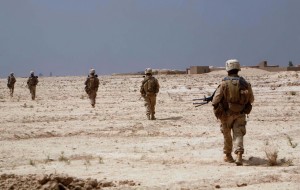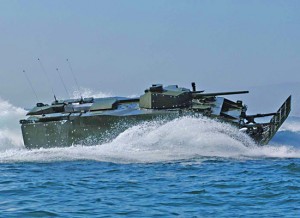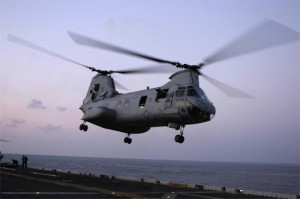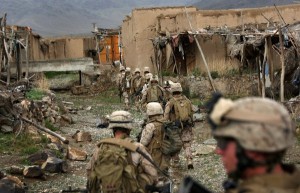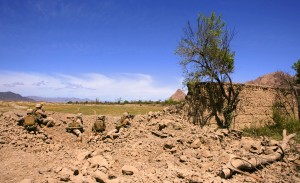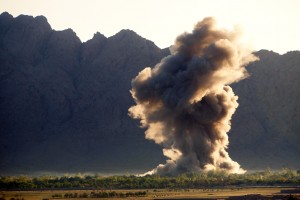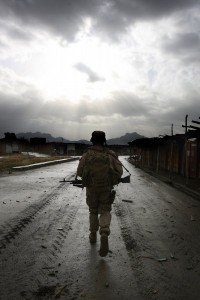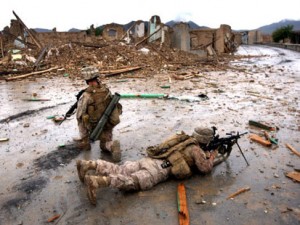Strategic Desisions Concerning Marines and Expeditionary Warfare
BY Herschel SmithFrom Government Executive:
The Marine Corps is pursuing a number of initiatives to give its units more fire support and more mobility to meet operational demands, with one near-term project being a less-sophisticated version of the Air Force’s powerful AC-130 gunship, Gen. James Conway said on Friday.
The Marine Corps commandant said the service is working on a longer-term proposal to use the Navy’s Littoral Combat Ships to provide high-volume fire support for Marine forces ashore. In addition, Marines are looking to modify their Mine-Resistant, Ambush-Protected vehicles to enable them to operate in Afghanistan’s rugged terrain, Conway told a Center for Strategic and International Studies forum.
Conway said the Marines “have lusted for years” over the AC-130’s capability but could not afford the sophisticated Air Force gunships. Instead, they are taking advantage of their KC-130J transport-tankers in a program called “Harvest Hawk,” he said. It consists of a “roll-on, roll-off package” that can be installed in hours and gives the KC-130s the ability to fire a 30mm rapid-fire gun and Hellfire missiles in support of ground forces, Conway said. “I think you’re going to see one in [Afghanistan] before the end of the calendar year.”
A Marine spokesman said later that “this is not intended to be a gunship” but a response to an urgent need of Marines in Afghanistan who want persistent intelligence, surveillance and reconnaissance capabilities. “The ISR is the priority, but we also want the capability to use some weapons against targets we can see,” the spokesman said.
The commandant said he has an agreement with Adm. Gary Roughead, the chief of naval operations, to examine use of a “box of rockets” that could be installed on an LCS to provide fire support for Marines ashore. It could replace the capabilities the Marines expected from the Advanced Gun System developed for the DDG-1000 destroyer, whose production is being stopped at three ships.
LCS is designed to accept a variety of “mission packages,” which include weapons, sensors, controls and operators that enable a ship to perform a variety of combat assignments. A Marine fire-support package was not one of the three original missions developed for LCS but has been discussed recently.
One proposal has been to use the non-line-of-sight launch system being developed as part of the Army’s Future Combat Systems. But that system does not have the range the Marines would need, Conway said. Systems that would have the range could not provide the volume of fire needed, he added. He did not provide any indication of when a satisfactory system could be available.
Commentary & Analysis
The Commandant has been in a fight with the Navy for a while now over the issue of its refusal to go closer to shore than 25 miles – the horizon – and thus his call for support of the Expeditionary Fighting Vehicle. In order to do forcible entry, Marines need to project firepower on shore, and this vehicle must be able to function on both the land and sea.
But The Captain’s Journal has opposed the EFV for reasons going beyond its design and maintenance problems and cost overruns. Basically, this vehicle will never be used as a staple of land operations. Its primary use will be from sea to shore and then slightly beyond.
The Littoral Combat Ship is anything but a combat ship. It has a small crew and essentially no forward force projection capability. It is a horrible platform for support of the Marines or a Marine Expeditionary Unit, and backfitting it with a “box of rockets” will likely prove to be problematic and not what the Marines were after.
Let’s assume that as a policy position we need forcible entry from the sea. Delivery of Marines without heavy firepower is probably not a good idea, and we have recommended a delay in the retirement of the CH-46 (from which Marines can fastrope) and investment in a new generation of Marine attack helicopters. The Navy must be pressed to be more involved in the delivery of heavy equipment (such as MRAPs, tanks, armored personnel carriers, etc.) after the Marines have accomplished forcible entry and if the strategy involves a protracted engagement.
We have also recommended a new generation of Marine vehicles similar to the Army Stryker. Heavy investment in a generation of vehicles, fighting or otherwise, that has as its sole use operation in littoral waters is probably not a wise investment of limited resources. No one intends for protracted land use of the EFV, and that itself is a telling observation. It is basically a useless platform without the necessity for forcible entry or the threat of it.
As for the air transport turned gunship, the Marine spokesman’s words are confusing and probably unnecessary. A gunship is exactly what is desired and needed. This kind of adaptive innovation is to be commended, and the Marines in Afghanistan will benefit from this improvisation.
Concluding, TCJ doubts that the LCS can successfully deliver high volume fire in support of Marines on shore, doubts the necessity for a fighting vehicle that has as its sole use operation in littoral waters, and has recommended other means of forward force projection (such as use of the F-35 off the deck of the Amphibious Assault Docks, additional Navy involvement to land heavier vehicles, and a new generation of Marine attack helicopters). All of the above would seem to be a better use of limited monies that either the EFV or the modified LCS.
As for the necessity for forcible entry from the sea, it was Colin Powell who observed that:
Lying offshore, ready to act, the presence of ships and Marines sometimes means much more than just having air power or ship’s fire, when it comes to deterring a crisis. And the ships and Marines may not have to do anything but lie offshore. It is hard to lie offshore with a C-141 or C-130 full of airborne troops.
Nice words, but a very expensive way to level threats at other nations. A Battalion of Marine infantry sitting on board an Amphibious Assault Dock for seven to nine months doing nothing is an awful waste of resources (and also a sitting duck for land-based surface to surface missiles). The expeditionary concept should be applied sparingly and with frugality. The capabilities of the Marines are needed across the globe in real time active and ongoing operations, not “could be,” “would be,” “maybe” and “we want it not to be” operations.
Prior:
Arguments Over the EFV and V-22
Navy and Marines to Part Ways Over Expeditionary Strike Groups?
